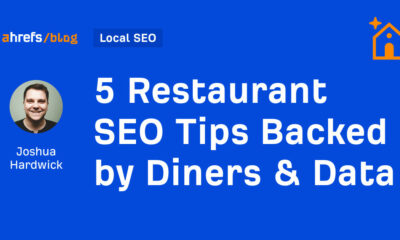SEO
How To Sell On Instagram: 11 Tips

Instagram is one of the biggest social platforms in the world, with over one billion users globally.
And your target audience isn’t just browsing the app – they’re also shopping.
This means you have a giant opportunity to get your products or services in front of people who need and want them – all with the creative opportunities a visual platform like Instagram provides.
I’ve earned over $32,500 in the past five years on Instagram.
It wasn’t my main selling platform. However, it was a great side income generator and a place I could have fun and experiment a little.
With that said, because it’s so popular, Instagram can also be crowded.
Here are some tips to help you get seen and be more successful selling on Instagram.
1. Ensure Your Account Is A “Business” Account
Before you can expect to make a dollar on Instagram, you must have some foundations in place.
First up: Ensure your account is a “Business” account.
This may seem obvious, but it’s important.
Business accounts have specific features that make marketing easier, such as:
- Insights about your audience.
- More options to add valuable information to your profile to help people find/connect with you outside the app.
- The ability to promote posts to reach more people.
2. Double-Check Your Branding
Next up, double-check that your branding is consistent across channels, including Instagram.
This keeps your presence recognizable and memorable.
Your profile picture, the style of your posts, and even your bio should all mesh with your existing brand presence.
For inspiration, check out accounts like @magnolia and @teachable.
3. Stay Consistent And Provide Value
How do you sell on Instagram once you have a presence there?
Just like with your other content, focus on consistency and providing value – not just selling.
A sales-y account is a huge turn-off for many people.
If all you post are product features with links to buy, you won’t have an engaged audience for long.
And, as you may know, an engaged audience is crucial to better conversions.
People who know, like, and trust you are far more likely to buy.
Consistent, high-quality Instagram content is vital to the selling equation.
Posting regularly – and not just in Reels or Stories – helps build that trust over time with a foundation of high-value, static posts, and carousel posts.
4. Create High-Quality Posts To Sell More On Instagram
High-quality posts help build your presence on Instagram and attract new followers, who could eventually become customers.
What do high-quality posts look like?
- High-quality imagery that blends into your overall brand vibe.
- Valuable, relevant information – either in the post image itself or in the caption – that proves your expertise, is topically relevant to your industry and gives your audience something to chew on (for less serious accounts, entertainment value counts, too!).
- Reliable posting your audience can count on (meaning you don’t disappear without notice for days or weeks at a time).
- Part of a planned content schedule mapped out weeks in advance as part of an overarching content strategy.
4. Use Smart Tools
Managing your Instagram account manually is a recipe for a headache.
Posting daily, sometimes multiple times a day, in various formats, can get exhausting.
Luckily, quite a few tools exist to help you plan out your Instagram grid to look cohesive and stay consistent.
A good tool will also help you schedule posts and create captions with relevant hashtags.
A few tools to consider:
- MeetEdgar – Lots of great features, including an automatic content scheduler that pulls posts from your library.
- Later – An all-in-one tool with a bunch of flexible plans.
- Agorapulse – A tool for managing all your social accounts, not just Instagram.
5. Post Reels Addressing Pain Points
For best results, use all the features at your disposal for selling on Instagram.
One great strategy is to post Reels that specifically address a tough pain point for your audience.
The solution you provide should be your product/service, which you can link to in your bio and mention in the Reel itself or the caption.
6. Use The “Link in Bio” Strategically
To sell more on Instagram, don’t link to your homepage in your bio.
Instead, link to a targeted landing page where customers coming from the platform can make a purchase.
You can change up the link to point to various landing pages tied to specific products, then add CTAs to your “link in bio” on static posts featuring those products.
Since you can’t link in static posts directly, this is a great way to get around that.
For an example, check out this post from VSCO, and note where they direct you to “Discover more through the link in our bio.”
7. Link To Products/Services In Stories
Getting on Stories and sharing about a product or service is another great way to sell on Instagram – especially since you can directly link to the product with a sticker.
It doesn’t have to be fancy, either – talk about the product straight to the camera and show it off, tell a story about a client who had success with a service, etc.
You can add a link sticker pointing directly to the product page right on the story.
By the way, this feature used to be locked for some types of users, but Instagram recently opened it up to everyone.
8. Save Stories Featuring Products To Highlights
Have some of your stories featuring products done really well? There’s no need to let them disappear into the ether – save them to your Story Highlights!
Make sure to create a specific Highlight just for stories featuring products so customers can easily find them. Look at how Magnolia has done it on their profile — they kept it simple and titled their product highlights “shop.”
You can also create different highlights for different product types, etc.
9. Promote Posts Featuring Products/Services
Promoting (or “boosting”) a product post is one of the easiest ways to create an Instagram ad.
This will get your post more visibility and traction and, thus, more eyes on your product or service.
Specifically, promote posts that are already doing fairly well in terms of engagement.
These posts have a better chance of performing in front of new eyes since you know they appeal to your existing audience.
Check out Instagram’s short, visual guide to boosting posts for some more good tips.
10. Use Hashtags Wisely
Using hashtags with many of the selling tips in this guide can give your products/services an even bigger boost.
The right hashtags can make a huge difference in how easily new customers can find you, your business, and your products.
Spend some time researching these and tag posts, Stories, and Reels accordingly.
Don’t forget about branded hashtags, either.
These are tags you create just for your brand and products and can help customers who already shop with you find exactly what they’re looking for.
For example, Magnolia has a “#MagnoliaHomeRugs” hashtag so customers can find posts featuring this product type.
11. Sell With Instagram Shopping
Finally, don’t forget Instagram has rolled out a feature that lets you sell directly inside the app: Instagram Shopping.
After you enroll and connect your online store, you can create a “shop” on the app and link directly to products in your shop in posts, Reels, and Stories.
Get Started Selling On Instagram
It’s pretty easy to start selling on Instagram, whether you have an established brand with a website or just getting into online selling.
That said, a good content strategy will help you sell better.
After all, selling online these days is as much about brand trust as it is about showcasing products smartly.
Once you nail both, the sky’s the limit.
More resources:
Featured Image: Look Studio/Shutterstock









![How to Create A Website to Sell Products In 8 Steps [+6 Expert Tips] How to Create A Website to Sell Products In 8 Steps [+6 Expert Tips]](https://articles.entireweb.com/wp-content/uploads/2024/10/1727868370_How-to-Create-A-Website-to-Sell-Products-In-8.webp-400x240.webp)
![How to Create A Website to Sell Products In 8 Steps [+6 Expert Tips] How to Create A Website to Sell Products In 8 Steps [+6 Expert Tips]](https://articles.entireweb.com/wp-content/uploads/2024/10/1727868370_How-to-Create-A-Website-to-Sell-Products-In-8.webp-80x80.webp)








You must be logged in to post a comment Login